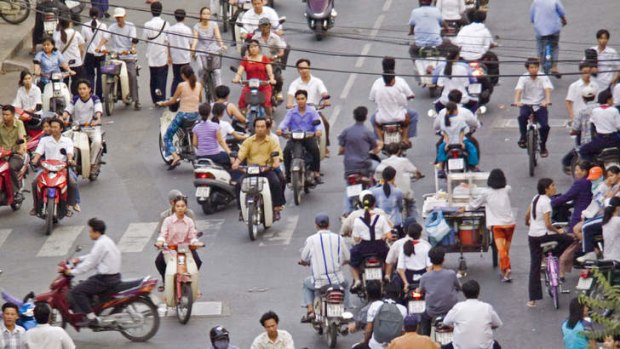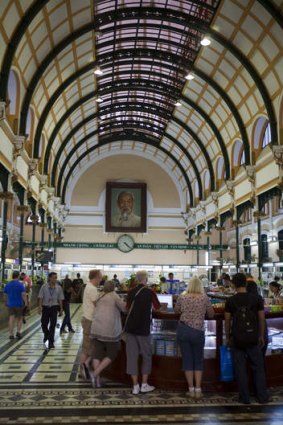A visit to Ho Chi Minh City is an encounter with exotic food, French colonial architecture and memories of war, writes Guy Wilkinson.
1 Cheap eats
Ho Chi Minh City (also still called Saigon) is famous for its pho (traditional Vietnamese noodle soup) and pork rolls. Often the best places are shops and stalls named after family members, such as "Aunty" or "Chi" (meaning sister) followed by a number representing their order in the family and, finally, their name. Though many chains, such as Pho24 and Pho 2000, do big business these days, you can't beat family-run outfits for the real deal.

Bustling street ... a scooter tour as an exhilarating way to explore the city.Credit: Getty Images
2 Late-night pedicure/spa
Manicure and pedicure shops are everywhere, particularly around the Pham Ngu Lao area, and most are open late into the night. Happily, some will even serve you a glass of wine or offer a massage, and a basic treatment will probably cost you less than half what it would back home (expect to pay about $6 for a set). Those looking to take the pampering up a notch might try My Spa or Spa Authentic. myspa.com.vn.
3 Scooter tours

Grand architecture ... inside Central Post Office, designed by Gustave Eiffel.Credit: Getty Images
Exploring the streets from the back seat of a Vespa is an exhilarating way to get a feel for a city with nearly 5 million motorbikes. To get your orientation fast, jump on an organised tour with an emphasis on food, nightlife, iconic sights or unusual attractions; a guide can help you discover the hot spots. Note that motorbike helmets are compulsory in Vietnam. For shorter day tours, try xotours.vn, or vietnamvespaadventures.com for longer excursions.
4 War Remnants Museum
Not for the squeamish, the War Remnants Museum documents the brutality of the Vietnam War and, although it has received criticism for its alleged propagandist tone, it remains one of the most visited museums in the country, attracting more than half a million visitors a year. Retired military vehicles such as "Huey" helicopters, attack bombers and even an M48 Patton tank dominate the front yard while, inside, a harrowing selection of text and photographic exhibits tell the story. (Open 7.30am-noon and 1.30-5pm.)
5 Bonsai River Cruise
Though it's true the Saigon River has serious pollution issues, a Bonsai dinner cruise is still a unique experience. Watch the city lights at sunset while sipping a Tom Collins from the deck of a traditional 19th-century dragon boat, take in a show and enjoy a buffet meal in style. Try to pre-book and stretch your dollar for a more boutique cruise if funds permit. bonsaicruise.com.vn.
6 Fresh beer
Found on most street corners and in ramshackle bars, fresh beer, or "bia hoi", is Vietnam's answer to microbrewing. First introduced by the Czechs, it's free of preservatives and therefore best gulped down immediately. The standard is seriously variable, but it certainly won't hurt your wallet (expect to pay about 35¢ to 40¢ a glass), so trial and error is part of the fun. Look out for the ubiquitous hand-scrawled Bia Hoi signs.
7 Central Post Office and Notre-Dame cathedral
Designed and built by French architect Gustave Eiffel (yes, he designed another fairly famous building or two), the Gothic-styled Saigon Central Post Office began its life in 1886 and remains one of the country's most celebrated structures. Inside, beneath a long, domed roof, walls decorated with French colonial maps flank a portrait of Ho Chi Minh, while the elaborate tiled floors complete the refined look. Opposite, the neo-Romanesque Notre-Dame cathedral, built between 1863 and 1880 by French colonists, is equally impressive.
8 Daring food
Fertilised duck eggs, fermented scorpion wine, deep-fried snake dishes: Vietnam is synonymous with cuisine to put hairs on your chest. Try to avoid restaurants prone to killing the snake in front of you (some diners like to feast on the still-beating heart). It's not kind to the snake and it won't increase virility. Reputable hotels can point you in the direction of a good restaurant with such creatures on the menu, or look out for glass bottles of snake wine known as "ruou thuoc" at most markets. Don't worry, the venom is neutralised by the ethanol.
9 Reunification Palace
Home of the president of South Vietnam during the "American War", as locals prefer to call the Vietnam War, this is the site where the first communist North Vietnamese tanks crashed through the gates on the morning of April 30, 1975, resulting in Saigon's official surrender. It is preserved almost exactly as it was in 1966, and you can look around at your leisure or take one of the free guided tours that depart every 15 minutes. (Open 7.30-11am and 1-4pm, Dinh Thong Nhat.)
10 Markets
There isn't much you can't buy from a market here, and although haggling is an art form requiring practice, it's still easy enough to pick up a bargain. District 1's Ben Thanh Market is certainly the most famous — there are more than 3000 stalls — but prices can often be inflated for tourists. For a lesser-known alternative, District 1's Tan Dinh specialises in silks and clothing material, while Ben Thanh night market is popular for those who prefer bargain hunting free from the noon heat.
11 Nightlife
Equivalent to Bangkok's famed Khao San Road, Pham Ngu Lao Street is HCMC's backpacker district, and it's where the revelry goes on long into the night. If you're looking for a more urbane option, try a rooftop bar hop of three of the city's most famous hotels, the Rex, Caravelle and Majestic. Yes, drinks are nosebleed expensive, but there's a colourful history and impressive view from each. For a refined colonial feel, Temple Club serves up a mean gin and tonic in a former temple guesthouse, while the Dong Khoi area is home to several live-music venues and more upmarket bars. anyarena.com.
12 Coffee
Since its introduction to Vietnam by French colonists in the 19th century, coffee has become a national obsession that rivals our own. Thanks to the intense humidity, iced coffee, known locally as "ca phe sua da", is generally favoured, and is brewed with a dark roast over a single metal french drip filter called "ca phe phin". Served with sweet condensed milk poured over ice, it's the perfect kick-start. Head to the Tan Tao Park to enjoy an early-morning brew with the locals or order a cup from any street vendor.
13 History Museum
Ensconced among lush botanic gardens in a beautiful 1929 French colonial building is the history museum, showcasing 4000 years of Vietnamese life and culture, starting from the Bronze Age. The collection includes items from the Cham and Khmer civilisations as well as artefacts illustrating mountain culture, revolutionary periods and even gifts bestowed on president Ho Chi Minh before his death. Not all exhibits are clearly labelled in English, but the setting practically justifies the visit. (Open Tuesday-Sunday, 8-11am and 1.30-4.30pm.)
14 Cooking classes
After sampling so much great food, chances are you'll want to replicate it. While many of the major hotels offer generic cooking lessons, a smaller-size class is a far better option. The best classes will team you with a chef to source ingredients at a nearby market before you learn to cook classic dishes such as summer rice rolls, rice noodle soups and many more. Most provide a take-home recipe pack so you can dazzle your mates back home. See saigoncookingclass.com for private, full-day and half-day classes.
15 Mekong Delta
Often dubbed the "rice bowl" of Vietnam, this 39,000-square-kilometre labyrinth of waterways remains one of the most densely populated parts of the country. About four hours' drive from the city, it's another world, where markets, villages and schools float on sprawling, life-sustaining estuaries. It's easiest to experience the delta on a tour, with most ranging from between one and five days. Spend a few days here if time permits; you can even make your way over to Cambodia by river, rather than by plane or bus. sinhbalo.com, mekongdeltatravel.com.
16 Cu Chi tunnels
You don't know the true meaning of claustrophobia until you've visited this vast network of interconnecting underground tunnels, 30 kilometres from Ho Chi Minh City. Used as operational headquarters by Vietcong guerillas during the Tet Offensive of 1968, they were instrumental in numerous military campaigns during the war and played a decisive role in defeating American forces. A guided tour allows you to explore the tunnels firsthand or even fire an AK-47 should you wish to emulate Chuck Norris for a day. cuchitunnel.org.vn.
17 Tailored clothing
While the World Heritage-listed riverside town of Hoi An, about 865 kilometres north of HCMC, remains Vietnam's top spot for quality tailoring, HCMC is another safe bet. For best results, go prepared, take magazine cutouts and bring clothing you want to replicate. Have a set budget in mind, too; it's easy to get talked into an entire new wardrobe. Allow a few days for the necessary adjustments. For high-end tailoring, try Mi Silk, 181 Dong Khoi, District 1.
18 Fine Arts Museum
Not far from the Ben Thanh Market, housed in a Chinese-influenced yellow and white colonial-era mansion, the Fine Arts Museum offers an extensive insight into Vietnamese aesthetics ranging from the country's earliest civilisations to the present day. Exhibits include anything from sculpture and paintings to pottery, abstract art and even weaponry. (Open Tuesday-Sunday, 9am-4.30pm, baotangmythuattphcm.vn.)
19 Pagodas and temples
The kaleidoscopic Jade Emperor Pagoda is widely regarded as the city's most spectacular, but it's one of many. For a dose of southern India's colour, check out Mariamman Temple, built in the 19th century by traders to honour the Hindu goddess Mariamman. For a wealth of Chinese temples, check out Cholon or take a day-trip to the Cao Dai temple at Tay Ninh, which is easily combined with a tour of the nearby Cu Chi tunnels. Incorporating aspects of Taoism, Buddhism, Confucianism and even Catholicism, it was built between 1933 and 1955. (Day tours, including the temple and tunnels, cost about $8.)
20 Shopping
Markets aside, there are plenty of options for high-end shopping. The major department stores are found at the central business district's Diamond Plaza or Saigon Centre — though prices won't differ much from home — while locals tend to favour Trai Street, straddling districts 1 and 5 for cheaper goods. Le Cong Kieu is famous for antiques, and the relatively new Vincom Centre opposite the Hotel Continental is a good bet for pricier, high-quality and boutique wares, while fashionistas will love Nguyen Hue Street.
Sign up for the Traveller Deals newsletter
Get exclusive travel deals delivered straight to your inbox. Sign up now.